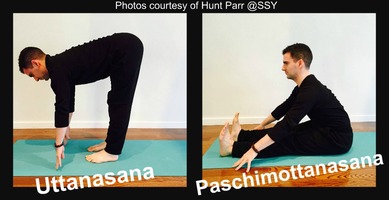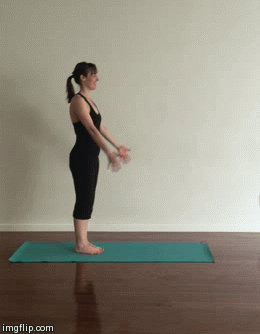By Yanoula Athanassakis and Lara Heimann
Let's talk about how to stretch your hamstrings in style and how to revamp your movement patterns for the 21st century!
As yoga teachers and fitness enthusiasts, we know that people are super concerned about hamstring flexibility. Even at parties or at the office, you'll oftentimes see people trying to convince their friends that they are either flexible or inflexible, by easily touching their toes (the blessed, "flexible" faction) or by straining hard to touch their toes ("the inflexible" outcasts).
The truth is, it's an urban myth that bending down and touching your toes means that your hamstrings are healthy and flexible. Nowadays we are sitting more than ever, so we definitely don't want to go from the typical seated position of a rounded spine and shortened hamstrings to attempting a deep forward bend.
What happens to your hamstrings in a forward bend
Uttanasana (standing forward bend, also translated as "intense forward-bend pose") is a staple of most yoga classes. Uttanasana is often confused with Paschimottanasana but here's a simple illustration.
In one pose you touch your toes while standing up, and in the other you do it while seated.
Both poses are meant to stretch our hamstrings, the group of muscles that run up and down the back of our legs. The hamstrings are made up of three muscles with tendons that cross over both the knee and hip joints. Most of us imagine it as one big muscle, "the hamstring," because historically, that's how it has been talked about... so let's change history.
In order to stretch the muscles that run from your ischial tuberosities (the bones you can feel in your butt) to the back of your knee, you have to stretch those points in opposite directions, and in order to do that, you need a forward tilt (or anterior tilt) in your pelvis. Because the muscle attaches to two joints, any decreased joint mobility affects the length of the muscle. The group of muscles that makeup "the hamstring" must be stretched from both attachment points.
Try these easy fixes to "touching your toes," and you'll safely increase your hamstring flexibility.
1. A smarter standing forward fold: In order to get a forward, or anterior pelvic tilt, start with a bit of an exaggerated arch in your back (it will flatten out as you fold). Keeping the backs of the knees and legs long (but not locked, always have a microbend), bend forward from the hips and still keep the back slightly arched.
Can you see a slight arch in my low back? Spot it!
2. Seated forward fold with propped up hips and pelvis: Take a seat on a folded towel or a pillow, stretch your legs out in front of you, and with a slight bend in the knees and the same "arch" in your low back, reach for your knees. Keeping the arch in your back, shut your eyes and focus on the "tugging" sensation in the backs of your legs. Let your hands rest wherever you feel sensation. Using a towel or strap around your feet is also a great way to do this.
3. Use a strap: while on your back with your legs long on the floor, bend one knee into your chest. Wrap a strap or towel around the ball of your foot. Keep the back of your hips snuggled into the floor and slow straighten your lifted leg. Take your opposite hand out in a "T" position to weight your hips and back down evenly to the floor. Press "out" through the heel of your foot and at the same time pull the strap towards you, increasing the resistance. Gently cross your foot over in alignment with the opposite hip and hold the foot here. Repeat on the opposite side.
Thank you Sam Scheffler and Andy Ko for modeling, and Sacred Sounds Yoga for providing the space.
Why does it matter if I stretch my hamstrings?
Too often while we're stretching, we are most concerned about keeping the legs straight and locked while trying to get the hands on the floor in a forward fold. If you're rounding at the pelvis to get the hands to the floor you risk straining the low back and possibly the hamstring tendons. Accomplishing this move does not matter for general function and mobility and can actually be injurious if done incorrectly.
Move your pelvis! (and open your hamstrings)
Moving from the pelvis safely and successfully helps gain and maintain hamstring flexibility. In part two of this post, we'll cover three simple ways to move your pelvis and access your hamstrings!
Drawing from her background as a physical therapist, Lara Heimann has combined her love of anatomy, creative movement and functional training to help people move better and do better. Lara owns YogaStream studio in Princeton, NJ and directs its YA-certified teacher training school.




